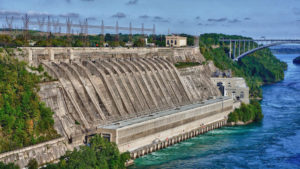 During an era of unprecedented change in the energy industry, hydropower offers a renewable and emission-free power source that boasts some unique attributes. Not only does hydropower provide reliable base-load generation, but it also has a high level of flexibility that enables storage and ramping capability. These qualities match well with the increasing need to balance intermittent renewable generation sources, such as wind and solar.
During an era of unprecedented change in the energy industry, hydropower offers a renewable and emission-free power source that boasts some unique attributes. Not only does hydropower provide reliable base-load generation, but it also has a high level of flexibility that enables storage and ramping capability. These qualities match well with the increasing need to balance intermittent renewable generation sources, such as wind and solar.
At just seven percent of total electricity generation in the U.S., hydropower already displaces about 200 million metric tons of carbon dioxide emissions that would otherwise come from thermal generation. It is efficient in its conversion of energy, uses reliable time-tested technology, and offers the lowest levelized cost of energy across all major sources. Though there are concerns over expanding hydropower due to environmental issues and potentially high initial costs, these can be addressed and are offset by the benefits of increased hydro capacity.
A few years ago, the U.S. Department of Energy issued a report finding that hydropower, one of the largest sources of renewable energy in the U.S. with over 100 gigawatts (GW), can sustainably grow by 50 gigawatts by 2050 with much of the growth coming by 2030. This would include upgrading some existing plants, building new smaller plants, adding new pumped storage, and adding power to the existing dams and canals (only three percent of our 80,000 dams have generation). And, earlier this month, the National Hydropower Association and Chelan County Public Utility District released a detailed blueprint for how hydropower can reach its potential, including proposals on market design, regulatory process, use of new technology, and operational practices.
Creating more capacity for meeting peak demand will be critical to avoiding reliability concerns as more areas adopt clean energy policies that call upon intermittent generation. Hydropower is well-positioned to help balance the competing interests of limiting emissions and the thirst for energy to fuel our tech-savvy homes, vehicles, and industries, and to help us strategically meet the challenges ahead.
Two important questions, my answer to the first one is to realize that almost all of the traditional hydropower locations have already been used. With great effect but the problem… Read more »
We would like to share this Hydropower video and summary with our community from a briefing hosted by our partner organization, the Environmental and Energy Study Institute.
A new analysis by Bloomberg New Energy Finance says that 50 percent of the world’s energy will come from solar and wind by 2050. Solar and wind are already cost… Read more »